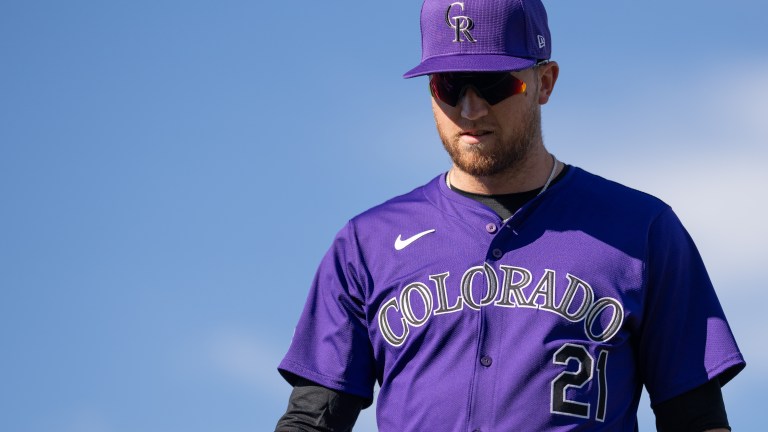Kyle Freeland’s Rebound Provides Valuable Lesson for the Rockies Young Starters
Kyle Freeland's rebound last year provided a valuable lesson to the Colorado Rockies' other young starters.

SCOTTSDALE, Ariz. — In only his second season as a big leaguer, Kyle Freeland accomplished something that only four pitchers had in the entire existence of the Colorado Rockies: earn a vote for the National League Cy Young Award.
The Denver-native posted a franchise-record 2.85 ERA over 33 starts in 2018 and finish fourth for the top pitching award in the game. The next season, Freeland suffered a fall from grace. He struggled so badly through the opening months of 2019 that it required a six-week stint in the minors.
“I really struggled to make that adjustment and figure out what’s going on and actually be open to change,” Freeland said of his 2019 mindset. “I just thought I should just keep trying what I’m trying, hopefully it would work out. And that usually never works out.”
So when Freeland was charged with 10 earned runs on Opening Day 2024 against the Arizona Diamondbacks and went on the injured list with a 13.21 ERA on April 19, he made sure history would not repeat itself.
“I had a lot of time to think, go over things, tweak some things, mess with some things, talk to coaches, talk to teammates,” he said of last season.
“The amount of confidence that I had coming out of camp, going into the season, was as high as it could possibly be, and to have that just absolutely ripped away from me in four starts, that’s a tough thing mentally to overcome. Being able to mentally overcome that, that comes with time and maturity.”
Rebound After Rockie Start
Freeland returned from his first trip to the 60-day IL in his eight-year career with six shutout innings on June 23 at home against the Washington Nationals . Before his final start of the campaign, the southpaw had a 3.57 ERA across 16 starts, one of his best stretches at any point with Colorado.
“He bounced back,” manager Bud Black said of Freeland’s 2024. “He’s got that will, he’s got that competitive spirit, which I say all the time about him. When it’s his day, we expect and he expects a good performance.”
As fastball velocity decreased for Freeland in recent years, opposing batters exit velocity slowly increased. Though the trend continued in 2024 for hitters, it did not for his four-seam fastball which jumped to 91.6 mph, his highest average velocity since 2020.
The biggest change for Freeland’s game is an ability to pull from experiences, something he couldn’t have done when he first entered the league at 24 years old.
“I think intelligence just plays a massive role in that of learning the league, learning your opponents, learning the teams that you’re playing against, the ballparks that you’re playing in, listening to your body,” he said.
“All that stuff comes into play as you get older in this game and start maturing more and more in this game, being able to continue to learn and always wanting to continue to learn.”
Teaching By Example
There’s an entire locker room of young players with a lot to learn. A total of 15 non-roster invitees have yet to make their big league debut. Three others on the 40-man roster have yet to reach The Show. In the bullpen, only two pitchers with three years of service time.
Whether or not these prospects want to learn is a horse of a different color.
“Generally speaking, you get to the big leagues by having your talent, and that is what brought you to the big leagues,” Black explained.
“You feel confident about it, and not that you’re stubborn, but a lot of times there’s the thought of, ‘Hey, I got here. Why do I need to change?’ And usually, some guys have some early success. But as the game goes on and you stay in the big leagues, you mature, you learn that there are always adjustments to be made and changes to keep pace with what’s going on around you in your performance.”
Chase Dollander will have an opportunity to earn a place in the starting rotation. Sean Sullivan, slowed this spring following offseason hip surgery, doesn’t seem far behind in the terms of performance. Carson Palmquist finished at Triple-A and Gabriel Hughes is ready for his first full-season since Tommy John surgery in 2023.
Any and all of those players may have to learn the hard way. If Freeland has anything to say about it, perhaps they’ll learn through his experience.
“With these young guys, it’s very easy to help set them up for (overcoming challenges). It’s going to happen. This game is full of failures,” Freeland said.
“It’s how you rebound from that failure, how you get back up from that failure. And when you talk with these young guys about failure and making that adjustment, you can set them up with, ‘Hey, it’s gonna happen. You just have to be open to change.’”
The return of Antonio Senzatela and Germán Márquez is a positive change the rotation hasn’t had for a few years. There were moments of pressing by the rotation in order to pick up the slack.
Now, that starting pitching depth is a boon for a franchise attempting to avoid 100 losses for the third consecutive season.
It’s also two more veterans that can provide support to these minor league arms over the next six weeks of camp and, for those who make the 26-man roster, through the grind of the 162-game schedule.
“You have to be open to having a conversation with somebody, having a conversation with a teammate, a coach, whoever, to help you navigate through whatever rut you’re in at that time and try to make those ruts as short as possible,” Freeland said. “And the help can come from mostly your teammates and your mindset of how you go about it.”
Scottsdale Scuttlebutt
- After Jacob Stallings, a trio of catchers are battling for playing time: Drew Romo, Hunter Goodman and Austin Nola. Asked if whether or not the team could possibly carry three catcher, especially if Goodman plays some corner outfield and first base, Black shot down the idea. Goodman needs to focus on catching full-time, so such a scenario would hinder his growth. It’ll be two catchers on Opening Day in Tampa on March 28.
- Some of the veteran players in camp aren’t putting much attention on the automatic ball-strike system (ABS) being implemented for the Majors during Spring Training. It will be a unique experience and one worth getting acclimated to, but there’s a regular season to prepare for that won’t have ABS as part of it.
